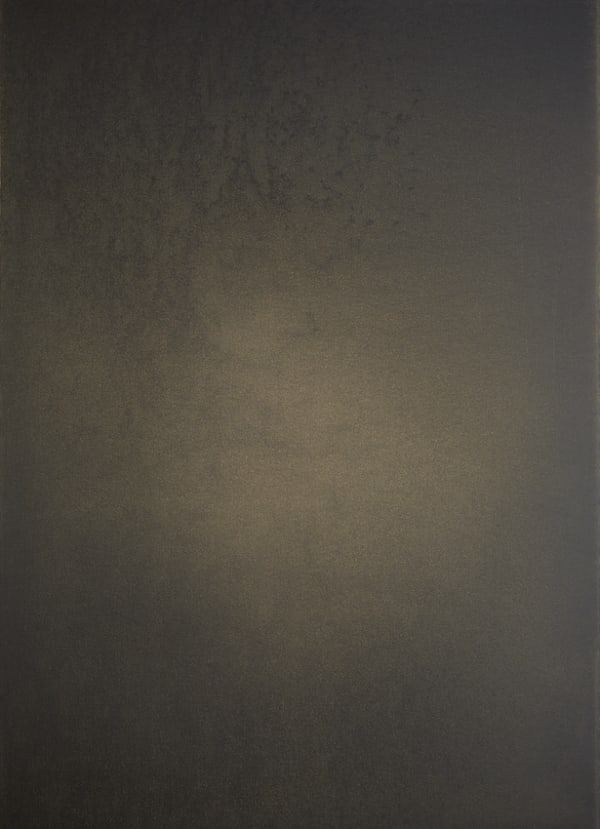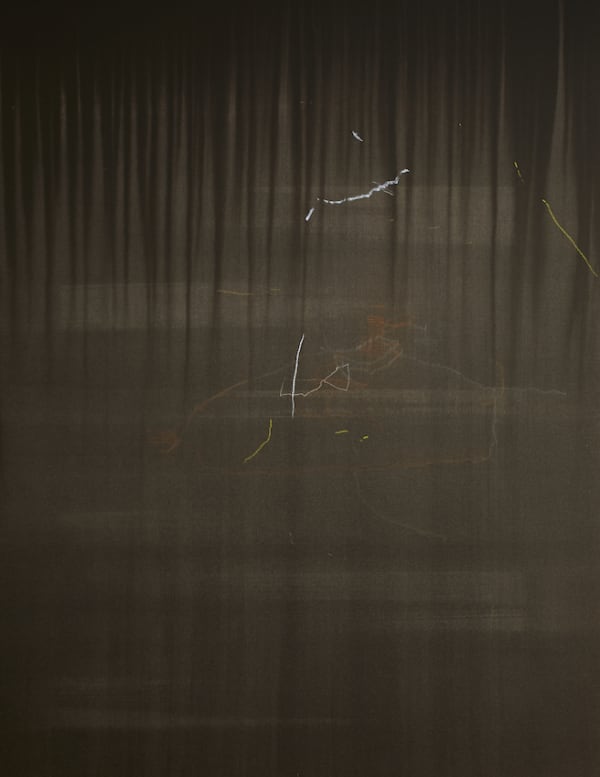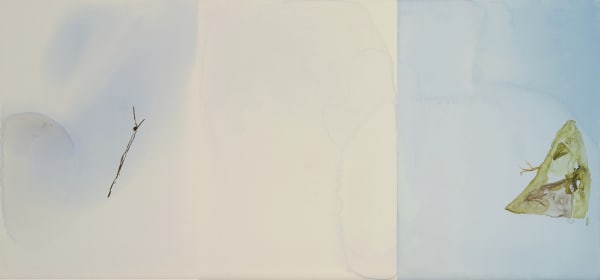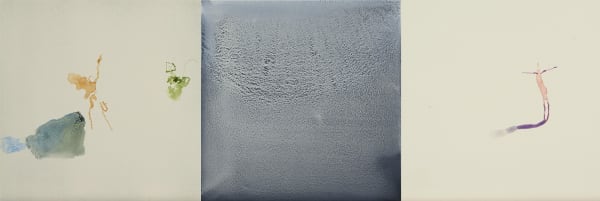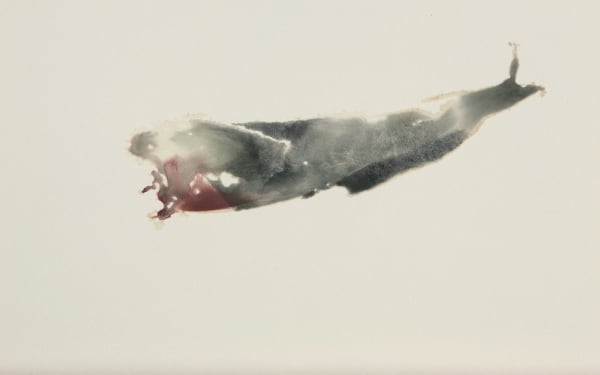Sara Maher: In (and out of) the Grey
Sara Maher ‘Working with consciousness’i
I recall the time I found the drift-stick along the Lunawanna foreshore...it resembled the curved neck and head of the cormorant that perched on the orange buoy, a little way out from the jetty where I sat at sundown.
In October 2020, Sara Maher spent four weeks on Lunawanna-alonnah (Bruny Island) as the recipient of the Bruny20 Arts Fellowship residency. She spent her time there making, thinking, writing and drawing, navigating histories and places to which she feels she belongs and does not belong. Lunawanna-alonnah Country has been the home of the Nuenonne people for millennia. The Bruny20 residency gave Maher four weeks to navigate what this might mean as an artist of Irish-European heritage, how to respond as a temporary resident on land marked by violence and mourning, how to connect to place beyond the constraints of European ways of knowing, and how to hold this experience lightly but firmly, turning it over in her hands.
In the European tongue, the Latin word for reside, ‘residere’ meaning “to sit, settle down”, shares its root with ‘residuum’, "a remainder, that which is left behind"ii. For Maher, the Bruny20 residency straddled these fields of meaning as she embarked on an uneasy negotiation of the shifting territories of absence and presence, tracing histories and residues in the land. In what she has described as ‘an emplaced reflection where awareness of a particular colonial history ruptures the present’iii the residency offered her an opportunity to respond to the survival of Lunawanna-alonnah Country, to pause and reflect on the multiple layers of history embedded there. Conscious of her ancestral link to the colonial past, Maher’s work from this time explores questions of belonging and the sprawling roots of European consciousness within her own heritage, confronting the deep strata of colonialism and the need to find new ways of working in the face of its legacy. Across variations in scale, intensity and materials, her works attempt to respond to the European act of ‘place- making’ against the deep foundations of Country, seeking potential for renewal within and beyond Lunawanna-alonnah’s shores and the ancestral lands of her imagination.
Once, the cormorant and I glimpsed a seal surface momentarily through the soupy-calm water. I wondered if it was a figment of my imagination, but the cormorant’s steady presence seemed to tell me otherwise. It felt right in that moment, and every sundown thereafter, to thank the being that watches through cormorant eyes for the very special time I was having.
Working with consciousness involves navigating boundaries as sites of crossing and exchange, transgression and interrogation. Sensing the flux of Lunawanna-alonnah’s historical and material boundaries, Maher’s process begins in quietude and solitude, asking questions of the land and its inhabitants. The hushed nature of her works evokes spaces of contemplation in which attentive listening and observing reveals ambient territories, immersed in the clay sediments and inky hues of the island but ethereal in energy and form. In the gaps between past and present, Maher explores sites where resonance becomes disturbance, where identities form and dissolve under the influence of ghosts, and where stories appear not as narrative but as etched lines, pools of light and rippling surfaces. Acknowledging the unsettled nature of any encounter with place, Maher invites us to observe the flux that defines these spaces, to hold it in consciousness and sense with her, the acute pressure in that moment of holding.
The stick was perfectly formed to be hand-held. It was asking to be a drawing tool...so I picked it up. Then, a disturbing rupture, a severance...It was a pistol! The kind European soldiers used in early colonial days.
In the shadows of Lunawanna-alonnah’s histories, Maher’s works emerge and unfold over time, forging connections with residual forms and deep structures of feeling. Natural materials energise her consciousness as she observes how they leak into memory through the sensory processes of seeing and touch, how they form links to the body through the call of a bird, the resonance of water and rock in space, the scattering of lines like bones echoing the tug and drift of materials around the edges of what might be called place. This is not a simple matter of locating herself on the maps of history or geography, but of charting the lineage of her body as it moves from the imagined there of Europe to the here of the Lunawanna-alonnah shorelines. Maher’s marks are traces of an embodied process through which she observes how she came to be here, and how she might connect to others who are not here, those who she does not know but to whom she is related. At the heart of such a process is a search for continuity, between absence and presence and across material forms, as she says ‘thinking about Country...I feel absence as a presence and as beyond a presence. I feel it as all life around ...it’s the animals, birds, trees, waters, skies, lands. Who’s not here is here.’iv
Perhaps I wasn’t prepared - in a public way - to approach the thoughts unfurling in me when Caroline asked would I share with the camera why I chose that particular stick. I spoke to my sense that it was a good shape, weight and size to be used as a drawing tool. The rest I kept to myself.
For Maher, consciousness unfolds through her processes of drawing and gathering materials from the land. A slow exploration of shifting states, acute and peripheral perceptions and phenomena, slippages between thinking, feeling and making, the interplay of the intimate and the immense. In the confluence of wind and water, sediments from the shoreline shapeshift in figures and forms, late sunlight casts a community of shadows. Within her atmospheric fields, beings mutate in soft, new lineages - an arm becomes a stick or horizon, black wings fly in and out of the grey, a pale, ghost face softens and lingers, belonging is a feeling that comes and goes. As this slow mirage emerges and unfolds, Maher lays a foundation for a consciousness informed by the responsibilities of working in and with place.
Lunawanna-alonnah is a keeper of knowledge, a site of endurance, a threshold between real and imaginary homelands. In response to its gravitational forces and the fluctuations of memory and materials, Maher’s works sense the way language forms between objects and their shadows, the way water shapes a cormorant from a drifting branch. Using watercolour, ink, pastel, paper, clay sediments, seeds, lost and found texts and photographs, she incorporates impermanence into her practice, suspending and releasing images as incomplete entities, watching them dissolve and evolve through material processes of saturating, hanging, turning, drying, resting. The murmurings of soft pastel outlines and stencilled hollows, fragmented dreamscapes, figures, houses and fields are all part of Maher’s process of ‘presencing’, of listening to the materiality of Country and forging ways to connect to and understand its meanings.
As the interview moved on, I became unsettled by the stick, by holding the stick...no matter how I held it or hid it under my hands, it was a pistol...It was the long shadow of history creeping into the present, and terrible collective memory moving through me.
Asking questions of the land involves a reckoning with herself as an introduced species, an incongruous resident. In the recesses of colonial memory, blackbirds become ancestors, sticks shaped like pistols force embedded traumas into material states of consciousness, provoking a desire to redress the weight of her European ancestry and to allow for renewed response. Is this even possible, Maher asks, to renew like this? To come to terms with European presence here, to recover from cultural amnesia and connect to the shards of invasion and injustice? Is it possible to release the problem of belonging and extend a broader antenna towards new ways of being and listening, to forge new meaning from the (dis)continuities of colonialism, place and home?
For all that, something inside said keep the stick...live with the stick...draw with the stick...face your ancestors through the stick. It is your responsibility to Country. And do not forget, when the shadows are too intense, that the stick is also the cormorant.
The leap into the ancestral imagination is complex in Maher’s work, informed by her sense of responsibility in being on Aboriginal land and the trajectories of her European heritage. Tracing bloodlines through distant and present homelands is a delicate process as she forges connections to Country that are both fragile and necessary. Allowing unsettled residues to find their shape, her works acknowledge long-held tensions between white settlement and unceded Aboriginal land and explore the European desire for belonging as a fantasy. Amidst the splittings and entanglements of these histories, Maher’s questioning of European constructs of the self and history points to ways of making with the land and re-imagining the lineages that hold her here. On such thresholds between worlds, Maher’s works reflect the perseverance of an artist facing the intimate challenges of residing on Lunawanna-alonnah, casting light on its residues and coming to terms with place.
The stick made it back to Hobart with me. At first, I hesitated and put it in the skip bin (enough was enough)...then, the following morning I felt bad for the cormorant...so I retrieved it, leant it in a flower vase on the windowsill, cormorant-head way up.
So that is the real answer to Caroline’s question.
i This essay was written through a series of conversations between Eliza Burke and Sara Maher over several months leading up to the ‘In (and out of) the Grey’ exhibition. The cormorant story in itallics was written by Maher just after the Bruny20 residency on 23rd Sept, 2020. The reference to Dr. Caroline Rannersberger, Creative Directive of Bruny20 came out of an interview with Maher on Lunawanna-alonnah as part of the Bruny20 supported residency program. The main essay text represents Burke’s response to the cormorant story and the residues encountered after each conversation and studio visit.
ii Definition: ‘reside (v) late 15c., residen, "to remain at a place," from Old french resider (15c.) and directly from Latin residere "sit down, settle; remain behind, rest, linger; be left," from re- "back, again" (see re-) + sedere "to sit," from PIE root *sed- (1) "to sit." Meaning "to dwell permanently" first attested 1570s. From https://www.etymonline.com/word/reside, accessed May 15th, 2021.
iii Maher, S, notes on an edited draft, May 2021.
iv Maher, S, notes on an edited draft, May 2021.
Eliza Burke, June 2021.
-
 Sara MaherBreathing Space, 2021ink on paper, framed106 x 148cm (paper size) 11.5 x 15.7cm (frame size)
Sara MaherBreathing Space, 2021ink on paper, framed106 x 148cm (paper size) 11.5 x 15.7cm (frame size)
Sold -
 Sara MaherFragile Connection, 2021ink and clay sediment (from Lunawanna-alonnah) on paper, framed147 x 106cm (paper size) 156 x 115cm (frame size)
Sara MaherFragile Connection, 2021ink and clay sediment (from Lunawanna-alonnah) on paper, framed147 x 106cm (paper size) 156 x 115cm (frame size)
AU$ 7,000.00 -
 Sara MaherThe Feeling of She-oak, 2021ink and clay sediment (from Lunawanna-alonnah) on paper, framed147 x 106cm (paper size) 158 x 116cm (frame size)
Sara MaherThe Feeling of She-oak, 2021ink and clay sediment (from Lunawanna-alonnah) on paper, framed147 x 106cm (paper size) 158 x 116cm (frame size)
AU$ 7,000.00 -
 Sara MaherCircling back, again and again - the act of returning, 2021ink and pastel on paper, framed106 x 141 (paper size) 116 x 150cm (framed size)AU$ 7,000.00
Sara MaherCircling back, again and again - the act of returning, 2021ink and pastel on paper, framed106 x 141 (paper size) 116 x 150cm (framed size)AU$ 7,000.00 -
 Sara MaherOpen Listening, 2021ink on paper, framed107 x 111cm (paper size) 115 x 120cm (frame size)
Sara MaherOpen Listening, 2021ink on paper, framed107 x 111cm (paper size) 115 x 120cm (frame size)
-
 Sara MaherThe Cracking and the Murmur, 2020ink and pastel on paper147 x 116cm (paper size)
Sara MaherThe Cracking and the Murmur, 2020ink and pastel on paper147 x 116cm (paper size)
AU$ 5,200.00 -
 Sara MaherListening Threads, 2020ink and pastel on paper147 x 116cm (paper size)
Sara MaherListening Threads, 2020ink and pastel on paper147 x 116cm (paper size)
AU$ 5,200.00 -
 Sara MaherBuried in the Body, 2020ink and pastel on paper147 x 116cm (paper size)
Sara MaherBuried in the Body, 2020ink and pastel on paper147 x 116cm (paper size)
AU$ 5,200.00 -
 Sara MaherShadow Being, 2021ink and pastel on paper147 x 116 cm (paper size)AU$ 5,200.00
Sara MaherShadow Being, 2021ink and pastel on paper147 x 116 cm (paper size)AU$ 5,200.00 -
 Sara Maheruntitled, 2020watercolour on paper, framedtriptych: 21 x 80.9cm (overall size) 27 x 87cm (frame size)
Sara Maheruntitled, 2020watercolour on paper, framedtriptych: 21 x 80.9cm (overall size) 27 x 87cm (frame size)
AU$ 1,650.00 -
 Sara MaherImaginary Homeland ( A house on a string, a marsh-lady with a water-divining twig (or is it a lasso), her shadow following behind, her self adrift in space, and a little person watching from afar) , 2020watercolour on paper, framedtriptych: 20 x 85.8cm (overall size) 26 x 92cm (frame size)
Sara MaherImaginary Homeland ( A house on a string, a marsh-lady with a water-divining twig (or is it a lasso), her shadow following behind, her self adrift in space, and a little person watching from afar) , 2020watercolour on paper, framedtriptych: 20 x 85.8cm (overall size) 26 x 92cm (frame size)
AU$ 1,650.00 -
 Sara MaherMeeting Place, 2021watercolour on clay board, framedtriptych: 18 x 38cm (overall size) 24 x 44.2cm (frame size)
Sara MaherMeeting Place, 2021watercolour on clay board, framedtriptych: 18 x 38cm (overall size) 24 x 44.2cm (frame size)
Sold -
 Sara MaherLand, Water, Sky, 2020watercolour on paper, framedtriptych: 13 x 62 cm (overall size) 18.5 x 67.5cm (frame size)
Sara MaherLand, Water, Sky, 2020watercolour on paper, framedtriptych: 13 x 62 cm (overall size) 18.5 x 67.5cm (frame size)
Sold -
 Sara MaherRecurring Dream Fragmentsmixed media on clay board, framedtriptych: 13 x 56 cm (overall size) 18.8 x 62cm (frame size)
Sara MaherRecurring Dream Fragmentsmixed media on clay board, framedtriptych: 13 x 56 cm (overall size) 18.8 x 62cm (frame size)
Sold -
 Sara MaherStick Person, 2021acrylic and watercolour on birch painting panel, framed30 x 20cm (panel size) 36 x 26cm (frame size)
Sara MaherStick Person, 2021acrylic and watercolour on birch painting panel, framed30 x 20cm (panel size) 36 x 26cm (frame size)
Sold -
 Sara MaherThinking in my Ancestor's shadow, 2021acrylic and watercolour on birch painting panel, framed30 x 20 cm (panel size) 36 x 26cm (frame size)
Sara MaherThinking in my Ancestor's shadow, 2021acrylic and watercolour on birch painting panel, framed30 x 20 cm (panel size) 36 x 26cm (frame size)
Sold -
 Sara MaherBeyond the Limb of the Moonwatercolour on clay board, framedtriptych: 12.5 x 38cm (overall board size) 18.8 x 44.3cm (frame size)
Sara MaherBeyond the Limb of the Moonwatercolour on clay board, framedtriptych: 12.5 x 38cm (overall board size) 18.8 x 44.3cm (frame size)
Sold -
 Sara MaherEarth and Sky Worlds, 2021watercolour on clay board, frameddiptych: 26 x 18cm (overall board size) 24 x 31.8cm (frame size)
Sara MaherEarth and Sky Worlds, 2021watercolour on clay board, frameddiptych: 26 x 18cm (overall board size) 24 x 31.8cm (frame size)
Sold -
 Sara MaherDream Popper, 2021watercolour on paper, framed17.8 x 12.7cm (paper size) 24 x 18.8cm (frame size)
Sara MaherDream Popper, 2021watercolour on paper, framed17.8 x 12.7cm (paper size) 24 x 18.8cm (frame size)
Sold -
 Sara MaherBig fish, 2020watercolour on paper, framed12.1 x 19.3cm (paper size) 18.2 x 25.4cm (frame size)
Sara MaherBig fish, 2020watercolour on paper, framed12.1 x 19.3cm (paper size) 18.2 x 25.4cm (frame size)
Sold -
 Sara MaherUnsettled Ancestor, 2020glass bottle, suspended collage fragment and de-seeded dandelion22 x 9.5 x 9.5cm (overall size)
Sara MaherUnsettled Ancestor, 2020glass bottle, suspended collage fragment and de-seeded dandelion22 x 9.5 x 9.5cm (overall size)
AU$ 850.00



